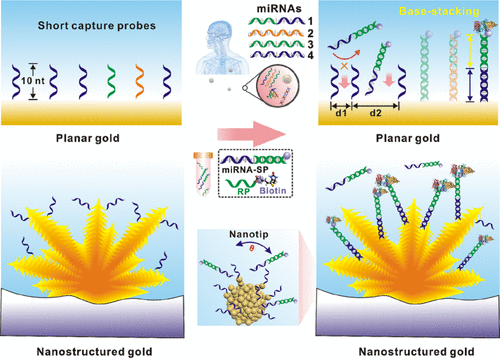Our official English website, www.x-mol.net, welcomes your feedback! (Note: you will need to create a separate account there.)
Nanostructuring Synergetic Base-Stacking Effect: An Enhanced Versatile Sandwich Sensor Enables Ultrasensitive Detection of MicroRNAs in Blood.
ACS Sensors ( IF 8.9 ) Pub Date : 2020-07-14 , DOI: 10.1021/acssensors.0c00772 Xin-Xin Peng 1 , Tongtong Guo 2 , Hao Lu 1 , Linlin Yue 1 , You Li 1, 3 , Dan Jin 1 , Guo-Jun Zhang 1 , Fan Yang 2
ACS Sensors ( IF 8.9 ) Pub Date : 2020-07-14 , DOI: 10.1021/acssensors.0c00772 Xin-Xin Peng 1 , Tongtong Guo 2 , Hao Lu 1 , Linlin Yue 1 , You Li 1, 3 , Dan Jin 1 , Guo-Jun Zhang 1 , Fan Yang 2
Affiliation

|
MicroRNA (MiRNA)-based noninvasive diagnostics are hampered by the challenge in the quantification of circulating miRNAs using a general strategy. Here, we present a base-stacking effect-mediated ultrasensitive electrochemical miRNA sensor (BSee-miR) with a universal sandwich configuration. In the BSee-miR, a short DNA probe (10 nucleotides) self-assembled on a gold electrode surface could effectively capture the target miRNA synergizing with another sequence based on coaxial sandwich base-stacking, which rivals the fully complementary strength. Importantly, such a sandwich structure is flexible to incorporate signal amplification strategies (e.g., biotin–avidin) that are usually difficult to achieve in short sequence detection. Using this design, the BSee-miR achieves a broad dynamic range with a detection limit down to 7.5 fM. Furthermore, we found a high-curvature nanostructuring synergetic base-stacking effect that could improve the sensitivity of the BSee-miR by two orders of magnitude (79.3 aM). Our BSee-miR also has a single-base resolution to discriminate the highly homologous miRNAs. More importantly, this approach is universal and has been used to probe target miRNAs varying in sequences and secondary structures. Our ultrasensitive sensor could detect miRNA in cell lysates and human blood and distinguish cancer patients from normal individuals, promising a versatile tool to measure clinically relevant miRNAs for tumor diagnostics.
中文翻译:

纳米结构的协同碱基堆积效应:增强的多功能三明治传感器可实现血液中MicroRNA的超灵敏检测。
基于MicroRNA(MiRNA)的非侵入性诊断受到通用策略对循环miRNA定量的挑战的困扰。在这里,我们提出了一种具有通用三明治构型的碱基堆积效应介导的超敏电化学miRNA传感器(BSee-miR)。在BSee-miR中,在金电极表面上自组装的短DNA探针(10个核苷酸)可以有效捕获与基于同轴三明治碱基堆叠的另一序列协同作用的靶标miRNA,该序列可与完全互补的强度相媲美。重要的是,这种三明治结构可以灵活地包含通常在短序列检测中难以实现的信号放大策略(例如,生物素-亲和素)。使用这种设计,BSee-miR可以实现宽广的动态范围,且检测限低至7.5 fM。此外,我们发现了一种高曲率的纳米结构协同碱基堆积效应,可以将BSee-miR的灵敏度提高两个数量级(79.3 aM)。我们的BSee-miR还具有单碱基分辨率,可区分高度同源的miRNA。更重要的是,这种方法是通用的,已用于探测序列和二级结构不同的靶标miRNA。我们的超灵敏传感器可以检测细胞裂解液和人体血液中的miRNA,并将癌症患者与正常人区分开,有望成为一种用于测量临床相关miRNA的多功能工具,以进行肿瘤诊断。更重要的是,这种方法是通用的,已用于探测序列和二级结构不同的靶标miRNA。我们的超灵敏传感器可以检测细胞裂解液和人体血液中的miRNA,并将癌症患者与正常人区分开,有望成为一种用于测量临床相关miRNA的多功能工具,以进行肿瘤诊断。更重要的是,这种方法是通用的,已用于探测序列和二级结构不同的靶标miRNA。我们的超灵敏传感器可以检测细胞裂解液和人体血液中的miRNA,并将癌症患者与正常人区分开,有望成为一种用于测量临床相关miRNA的多功能工具,以进行肿瘤诊断。
更新日期:2020-08-28
中文翻译:

纳米结构的协同碱基堆积效应:增强的多功能三明治传感器可实现血液中MicroRNA的超灵敏检测。
基于MicroRNA(MiRNA)的非侵入性诊断受到通用策略对循环miRNA定量的挑战的困扰。在这里,我们提出了一种具有通用三明治构型的碱基堆积效应介导的超敏电化学miRNA传感器(BSee-miR)。在BSee-miR中,在金电极表面上自组装的短DNA探针(10个核苷酸)可以有效捕获与基于同轴三明治碱基堆叠的另一序列协同作用的靶标miRNA,该序列可与完全互补的强度相媲美。重要的是,这种三明治结构可以灵活地包含通常在短序列检测中难以实现的信号放大策略(例如,生物素-亲和素)。使用这种设计,BSee-miR可以实现宽广的动态范围,且检测限低至7.5 fM。此外,我们发现了一种高曲率的纳米结构协同碱基堆积效应,可以将BSee-miR的灵敏度提高两个数量级(79.3 aM)。我们的BSee-miR还具有单碱基分辨率,可区分高度同源的miRNA。更重要的是,这种方法是通用的,已用于探测序列和二级结构不同的靶标miRNA。我们的超灵敏传感器可以检测细胞裂解液和人体血液中的miRNA,并将癌症患者与正常人区分开,有望成为一种用于测量临床相关miRNA的多功能工具,以进行肿瘤诊断。更重要的是,这种方法是通用的,已用于探测序列和二级结构不同的靶标miRNA。我们的超灵敏传感器可以检测细胞裂解液和人体血液中的miRNA,并将癌症患者与正常人区分开,有望成为一种用于测量临床相关miRNA的多功能工具,以进行肿瘤诊断。更重要的是,这种方法是通用的,已用于探测序列和二级结构不同的靶标miRNA。我们的超灵敏传感器可以检测细胞裂解液和人体血液中的miRNA,并将癌症患者与正常人区分开,有望成为一种用于测量临床相关miRNA的多功能工具,以进行肿瘤诊断。



























 京公网安备 11010802027423号
京公网安备 11010802027423号